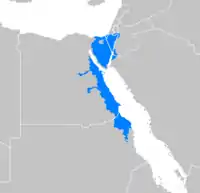Northwest Arabian Arabic
Northwest Arabian Arabic is a proposed[2] subfamily of Arabic encompassing the traditional dialects of the Sinai Peninsula, the Eastern Desert, the Negev, southern Jordan, and the northwestern corner of Saudi Arabia.[3]
| Northwest Arabian Arabic | |
|---|---|
 | |
| Native to | Egypt, Jordan, Israel, Palestine, Saudi Arabia |
Native speakers | 2.24 million (2015-2016)[1] |
Afro-Asiatic
| |
| Arabic alphabet | |
| Language codes | |
| ISO 639-3 | avl |
| Glottolog | east2690 |
In the Sinai Peninsula; the eastern desert of Egypt, the dialect of the Maʿāzah borders the dialect of the ʿAbābdah, who speak a dialect more closely related to Sudanese Arabic.[4]
In Saudi Arabia, the dialects of the eastern coast of the Gulf of Aqaba, the Hisma, and the Harrat al-Riha belong to the Northwest Arabian type, but the dialect of the Bili to the south is not closely related.[5]
Classification
The Northwest Arabian Arabic dialects display several innovations from Proto-Arabic:[2]
- The voiced reflex of *q ([g])
- The gaháwah syndrome: insertion of /a/ after X in (C)aXC(V) sequences where X is /h/, /ʿ/, /ḥ/, /ġ/, or /ḫ/, e.g. gahwa(h) > gaháwa(h) "coffee", baġl > baġal "mule".
- The definite article al- and the relative pronoun alli are stressable as an integral part of the word, e.g. álwalad, áljabal. The initial /a/ is stable enough to be preserved after -ī (-iy), which is dropped: f-albēt, rāʿ-álġanam.
- A number of typical Bedouin lexical items (gōṭar "to go", sōlaf "to tell, narrate", ṭabb "to arrive", nišad ~ nišád "to ask").
- Absence of tanwīn and its residues.
- Absence of final /n/ in the imperfect, 2nd person feminine singular, 2nd person masculine plural, and 3rd person masculine plural.
- The pronominal suffix of the 2nd person masculine plural is -ku (-kuw).
- Stressed variants -ī and -nī of the pronominal suffix in the 1st person singular.
- Plural comm. forms haḏalla, haḏallāk, etc.
- Initial /a/ in Forms VII, VIII, and X in the perfect, and stressed when in stressable position.
- Initial /a/ in a number of irregular nouns (amm, aḫt, aḫwan, adēn, afám).
Dialects, accents, and varieties
There are several differences between the western and eastern branches of Northwest Arabian Arabic:[2]
- In the eastern branch, the b- imperfect does not occur in plain colloquial, while in the entire western branch it is in regular use.
- The western branch makes use of an analytic genitive, šuġl, šuġlah, šuġlīn, šuġlāt as genitive markers.
- The western branch dialects have vowel harmony in the performative of the active imperfect of Form I, whereas in the eastern branch the vowel is mainly generalized /a/.
- In the dialects of the eastern branch and southern Sinai, the reflexes of *aw and *ay are well-established monophthongs /ō/ and /ē/, usually after back consonants and emphatics as well. In most dialects of the western branch, *aw and *ay have been partially monophthongized, but the new monophthongs fluctuate with long phonemes /ō/ ~ /ū/, /ē/ ~/ī/.
- The eastern branch dialects tend to (but not strictly) drop the initial /a/ in gaháwah forms: ghawa ~ gaháwa, nḫala, etc. In Sinai and Negev, the /a/ of the initial syllable is preserved.
- The imperfect of the I-w verbs in the western branch are of the type yawṣal, yōṣal, whereas in the eastern branch they are of the type yāṣal.
- 3rd person singular feminine object suffix: -ha/-hiy in Negev, -ha everywhere else.
- 3rd person singular masculine object suffix: C-ah in the eastern branch, phonetically conditioned C-ih/-ah in the western branch, C-u(h) in southern Sinai.
- 1st person plural common subject pronoun: ḥinna, iḥna in the eastern branch; iḥna, aḥna in the western branch.
- In the eastern branch and parts of Sinai, -a is the main reflex of -ā(ʾ) in neutral environments. In Negev and the eastern part of the northern Sinai littoral, it is -iy, in back environments -a.
Characteristics
The following are some archaic features retained from Proto-Arabic:[2]
- Gender distinction in the 2nd and 3rd person plural pronouns, pronominal suffixes, and finite verbal forms.
- Productivity of Form IV (aC1C2aC3, yiC1C2iC3).
- The initial /a/ in the definite article al- and the relative pronoun alli.
- Frequent and productive use of diminutives (glayyil "a little", ḫbayz "bread").
- Absence of affricated variants of /g/ (< */q/) and /k/.
- The use of the locative preposition fi (fiy).
- The invariable pronominal suffix -ki of the 2nd person feminine singular.
See also
References
- "Arabic, Eastern Egyptian (Sinai Peninsula) Bedawi Spoken". Ethnologue. Retrieved 2018-08-08.
- Palva, Heikki. ""Northwest Arabian Arabic." Encyclopedia of Arabic language and linguistics. Vol. III. Leiden – Boston: Brill 2008, pp. 400-408". Cite journal requires
|journal=(help) - Palva, Heikki. ""Northwest Arabian Arabic." Encyclopedia of Arabic language and linguistics. Vol. III. Leiden – Boston: Brill 2008, pp. 400-408". Cite journal requires
|journal=(help) - Jong, Rudolf Erik De (2011-04-11). A Grammar of the Bedouin Dialects of Central and Southern Sinai. BRILL. ISBN 978-9004201019.
- Palva, Heikki. ""Remarks on the Arabic Dialect of the Huweitat Tribe". Jerusalem Studies in Arabic and Islam 29 (2004), pp. 195-209. Studies in Honour of Moshe Piamenta". Cite journal requires
|journal=(help)
Sources
- Gordon, Raymond G.. Jr., ed. (2005), "Bedawi Arabic", Ethnologue: Languages of the World (15th ed.), Dallas: Summer Institute of Linguistics
- Haim Blanc. 1970. "The Arabic Dialect of the Negev Bedouins," Proceedings of the Israel Academy of Sciences and Humanities 4/7:112-150.
- Rudolf E. de Jong. 2000. A Grammar of the Bedouin Dialects of the Northern Sinai Littoral: Bridging the Linguistic Gap between the Eastern and Western Arab World. Leiden: Brill.
- Judith Rosenhouse. 1984. The Bedouin Arabic Dialects: General Problems and Close Analysis of North Israel Bedouin Dialects. Wiesbaden: Harrassowitz.